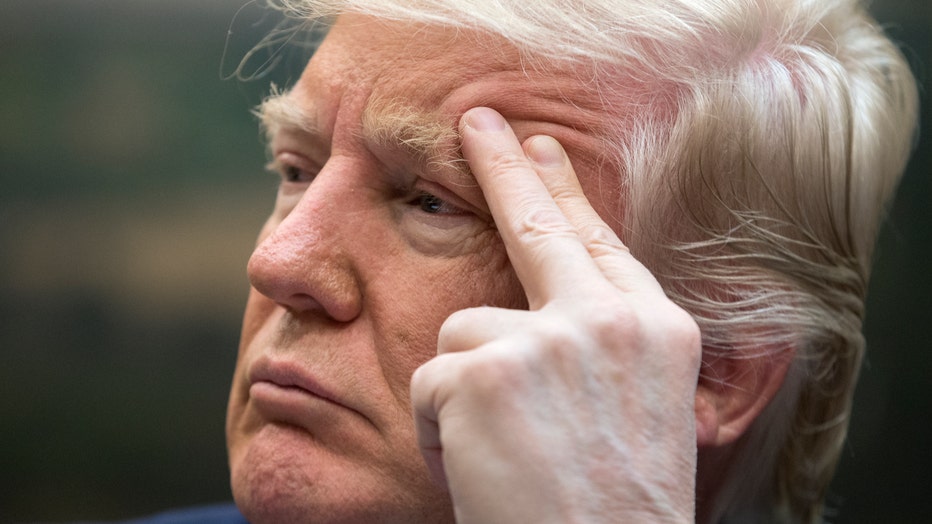How President Trump’s tax plan would have affected his newly leaked return


President Donald Trump attends a meeting on healthcare in the Roosevelt Room of the White House on March 13, 2017 (Michael Reynolds-Pool/Getty Images)
By Meg Wagner
Less than the average millionaire’s tax rate
President Donald Trump paid about 24 percent in taxes on the $153 million he made in 2005, thanks to a tax he has vowed to get rid of — without it, he’d have owed a meager 4 percent.
According to President Trump’s 2005 tax return — obtained by Pulitzer prize-winning journalist David Cay Johnston, who reported it on MSNBC’s “The Rachel Maddow Show” Tuesday night — the former businessman paid $36.5 million in income taxes.
President Trump, who has long refused to release his own tax returns, also paid about $1.9 million for his self-employmen tax, which goes toward Social Security and Medicare (calculating that in bumps his total tax rate to about 25 percent).
The vast majority of President Trump’s income taxes — a $31 million — came in the form of an Alternative Minimum Tax (AMT), a tax that prevents the U.S.’s top earners from paying minimal or no taxes by curbing the kinds of deductions and write-offs they can claim.
Without the AMT, President Trump would have only paid roughly $5.5 million, meaning he’d have forked over a mere 4 percent of his income to the government. The average American taxpayer pays about 10 percent, while those earning more than $1 million, on average, are taxed at a 27.4 percent rate.
President Trump has promised tax reform, which includes simplifying the tax code and eliminating the AMT.
It’s unclear who leaked the tax return to Johnston: He said he found it in his mailbox. But the White House partially verified its credibility in a statement that claimed President Trump paid roughly $38 million in taxes in a year he made $150 million.
“You know you are desperate for ratings when you are willing to violate the law to push a story about two pages of tax returns from over a decade ago,” the White House said in a statement, alluding to the fact that the unauthorized access to and publication of tax returns is a crime. “It is totally illegal to seal and publish tax returns.”
MSNBC claimed that it is protected under the First Amendment because it published material crucial to public interest.
A complicated system to ensure fairness
The AMT was enacted to make the tax system fairer by ensuring that ultra-wealthy Americans can’t use tax loopholes to their advantage.
In 1969, then-treasury secretary Joseph W. Barr revealed that 155 Americans making $200,000 (worth about $1.5 million today) or more paid absolutely no income tax, thanks to completely legal deductions.
The revelation caused public outrage, especially among lower- and middle-income Americans who were taxed at standard rates.
Congress immediately implemented an add-on tax for certain high-earning taxpayers, and lawmakers passed — and then-President Ronald Reagan signed into law — the current AMT in 1982. It’s a parallel system to the normal income tax system: High-income taxpayers calculate what they’d owe under the regular tax code and the AMT and pay whichever is higher.
The AMT eliminates or reduces many of the dedications that normal tax payers get to claim, making large chunks of what would be non-taxable income subject to taxes. For example, those using the AMT can’t deduct exemptions for their dependents, the state income taxes, or real estate property taxes.
Critics of the AMT have complained that many middle-class Americans get caught in it: A single person making $54,300 may be subjected to it, although income isn’t the only factor that determines a taxpayer's eligibility. Others have said it’s just too complicated.
$354 billion in lost revenue
Getting rid of the AMT would mean a massive revenue loss for the federal budget. The nonpartisan tax research group the Tax Foundation estimated that repealing it would cost the federal government $354 billion over the course of 10 years. In 2015 alone, the U.S. Treasury raked in $28.2 billion from the system.
President Trump’s proposed tax plan — which also promises the most significant tax cuts since the ones implemented under President Ronald Reagan — hasn’t passed Congress yet. Even with a Republican majority, it’s likely that the plan would need hefty compromises to get through.
In the meantime, the focus remains on President Trump’s newly discovered tax return: critics have renewed their demands that the president finally release his full tax-paying history.
The two-page 2005 report is only a single year and doesn’t include the pages that would detail his sources of income or show how much he donated to charity. There’s no clear reason why the 2005 return, labeled “client copy” was leaked instead of other years, although Johnston speculated that President Trump may have sent it himself.
Every presidential candidate since Richard Nixon has released his or her returns. On the campaign trail, President Trump promised he’d release his current returns, but then claimed he couldn’t because he was under audit by the Internal Revenue Service, (IRS officials have said an audit doesn’t affect a taxpayer’s ability to release their own returns.)
President Trump — whose team insisted that “people” don’t care about President Trump’s tax returns — has not said if he’ll release the rest of his documents in the wake of the leaked one. Instead, on Twitter, he bashed MSNBC and Johnston.
"Does anybody really believe that a reporter, who nobody ever heard of, 'went to his mailbox' and found my tax returns? @NBCNews FAKE NEWS!" he tweeted Tuesday night.

